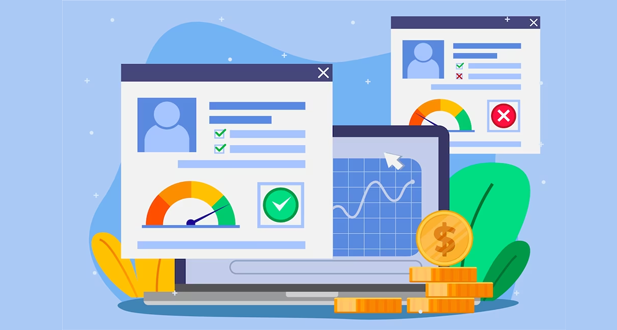A Loan Management System is a cutting-edge digital instrument that automates every step of the loan life cycle using artificial intelligence. With the help of this financial technology, you can substitute time-consuming, frequently requiring the verification of applicants’ trustworthiness and financial information conventional methods.
What is Loan Management System?
The complete loan life cycle, including loan servicing, reporting, customer service, syndication, and customer tracking, can be automated and streamlined with the help of a loan management system, a digital tool that aids lenders. It serves as a central data repository for lenders, storing all their financial records, creating new loans, and managing client information. As a result, it provides a comprehensive summary of all the various steps in the lending lifetime.
This unified platform also includes analytical tools that can be used to generate thorough reports on cash flow as well as insightful analysis and insights into automating the complete lending cycle. In contrast to the conventional paper-based way of servicing debts, it offers a readily deployable and scalable comprehensive loan administration system.
Features of the Perfect Loan Management Software
A perfect Loan Management Software should streamline and enhance every aspect of the loan process, from application to repayment. Here are the essential features that define the perfect loan management software:
Comprehensive Loan Origination
1. Automated Loan Application Processing
- Online Application Forms: User-friendly online forms for easy loan application submission.
- Document Management: Upload, store, and manage all required documents securely in one place.
- Credit Scoring Integration: Integrate with credit bureaus to automatically pull credit reports and scores.
Advanced Loan Servicing
2. Customizable Loan Products
- Flexible Loan Terms: Tailor loan terms and conditions to fit different loan products, such as personal, auto, mortgage, and business loans.
- Interest Calculation Options: Support various interest calculation methods, including fixed, floating, and reducing balance.
3. Automated Repayment Management
- Flexible Repayment Schedules: Offer various repayment frequencies (e.g., monthly, bi-weekly, weekly) to suit borrowers’ needs.
- Payment Gateway Integration: Integrate with multiple payment gateways to facilitate easy and secure online payments.
- Auto-Debit Functionality: Enable automatic deductions from borrowers’ accounts on due dates.
Robust Reporting and Analytics
4. Comprehensive Reporting
- Customizable Reports: Generate a wide range of reports, including delinquency, portfolio performance, and compliance reports.
- Dashboards and KPIs: Visualize key performance indicators (KPIs) and critical metrics on intuitive dashboards.
- Regulatory Compliance: Ensure adherence to industry regulations with built-in compliance reporting tools.
5. Advanced Analytics
- Predictive Analytics: Use machine learning and AI to predict borrower behavior and loan performance.
- Risk Assessment Tools: Identify and mitigate potential risks through detailed risk analysis.
- Performance Tracking: Monitor and analyze the performance of different loan products and branches.
Enhanced Security and Compliance
6. Data Security
- Encryption: Ensure all data is encrypted both in transit and at rest.
- Role-Based Access Control (RBAC): Implement RBAC to control access to sensitive information based on user roles.
- Audit Trails: Maintain comprehensive audit logs to track all system activities and user actions.
7. Regulatory Compliance
- Compliance Management: Stay updated with the latest regulatory requirements and ensure the system meets all compliance standards.
- Fraud Detection: Use advanced algorithms to detect and prevent fraudulent activities.
Loan management software can accomplish more in less time with greater precision than older systems because they are outfitted with the newest technologies, analytics, and game-changing tools like AI and machine learning.
Therefore, keep reading to learn what qualities to look for in the ideal loan management software if you’re a new-age lender hoping to give your company the push it requires to stick out in this crowded market.
1. Scalability: Any company wanting to expand and build up needs the right tools. The ideal loan management system should enable lenders to expand their operations, provide outstanding customer service, and broaden the range of products they give.
This allows lenders to boost their profit margins, expand into new markets, provide better solutions, and launch new goods more rapidly to meet the changing demands of developing markets. A scalable system assists in meeting the altered standards once a company has reached the development trajectory. The product’s scalability enables businesses to start modestly according to their needs.
2. Effortless implementation: It’s possible that the majority of start-ups and peer-to-peer financiers in this industry need access to specialised IT support. 24/7 access to an IT team is required to execute, manage, and troubleshoot problems emerging from such a sophisticated, data-critical technological solution. The good news is that most cloud-based debt management system providers offer fast installation and routine upkeep services like bug fixes, frequent upgrades, and IT help when required.
3. Integrated approach: The banking industry has many aspects, including hiring, credit evaluation, loan origination, underwriting, disbursal, and payback. By speeding up turnaround times and being more effective, integrating all these components into a single piece of software enables lending companies to save time, process loan requests quickly, and provide clients with an overall positive experience.
Therefore, when searching for the ideal debt administration software, seek one that enables you to assemble customisable modules into one seamless, integrated system. To improve borrower data, the system should also allow third-party connections. The company benefits from support for integration with CRM, ERP, and bookkeeping software because it provides a uniform perspective and reduces time spent on reworking.
4. Convenient entry: Lenders can keep all customer-related data in one place using loan management software solutions throughout the client lifecycle. They eliminate the bottleneck caused by storing and retrieving loan data from various platforms. Additionally, it enables the loan company to view the customer’s profile, the stage of lending they are in, their credit score, and all relevant information at a look from anywhere in the world.
5.Credit evaluation: The likelihood that lenders will choose interest rates and loan repayment conditions that reduce their risk and optimise revenues increases with the quality and accuracy of the credit evaluation. This is only feasible if the lenders comprehensively understand the debtors’ creditworthiness.
Since the majority of start-ups and peer-to-peer lenders are interested in exploring developing markets where potential clients lack credit histories, they will need access to software that offers alternative credit rating techniques and databases, such as social media behaviour, utility bill payment behaviour, tax data, or bank statement analysis, to reduce risk and make well-informed decisions about things like interest rates and repayment terms.
6. Automated Process: Robotic process automation, also known as process automation or RPA, is very effective at automating repetitive chores, speeding up turnaround times and increasing organisational productivity. It accomplishes this by speeding up routine tasks like loan assessment and credit analysis, lowering application filing and clearance periods and minimising human error. Therefore, the ideal debt administration system should incorporate sufficient automatic and customisation capabilities.
7. Objectivity: For as long as anyone can remember, banks and financiers have never been particularly transparent. Modern lenders want to alter that by making their operations more transparent, giving all parties—including customers—a better understanding of and greater confidence in the loan process. Having a mechanical interface that updates clients on the state of their loan application at each stage will give them a better user experience than they have ever had with conventional banks.
8. A flexible interface: The “mobile-friendly” is no longer just used to describe webpages and applications. To boost usage and tap into new markets, tech firms are working to make their complex, bulky software mobile-friendly. This is crucial for modern lenders targeting developing markets where clients might not have access to desktop or laptop computers but almost definitely have smartphones or inexpensive tablets.
As a result, having a mobile-friendly borrower or field staff UI is no longer an optional feature; it is now a feature you must seek in your loan management software system.
9. Insights and analytics: Best-in-class cloud-based debt administration tools give lenders gold in the shape of valuable data. By gathering, churning, and processing data from various sources and applying business intelligence to this data pool, loan management software can give lenders expert insight into market trends, help set KPIs, improve customer acquisition, find and remove blind spots and bottlenecks, and increase overall productivity.
10. Secure yet seamless: By establishing unified data storage that stakeholders can view with the proper rights from anywhere in the world, loan management software solutions enable lending organisations to expand and develop. It lessens the need for manual work, lowers the likelihood of human error, and speeds up procedures, increasing income.
While providing the finest loan administration software available, ensure it complies with industry-established data security and privacy standards and follows best practices for data security.
Considerations Before Choosing A Loan Management System:
1. A broader scope: A loan management system that can be used for various purposes, such as mortgage paperwork, asset funding, business leasing, or consumer loans, must be looked into.
2. Convenient: No matter how simple or complicated a business’ requirements may be, it is crucial to have a simple loan management system to set up and configure to those needs.
3. A Centralized Approach: A good LMS ensures that all of its loan application data is centralised into a comprehensive and single perspective for the loan section.
4.Quickness & Agility: An institution’s ability to approve and issue loans quickly is both a benefit to the organisation and a draw for customers.
5. Authenticated Access: The NBFCs prioritise the loan management system’s usability to approve loans and enable an effective business review and monitoring process. Financial institutions can obtain pertinent documents from third parties more quickly and without needless approvals by granting authorisation via credential-based access.
6. Support for technology and customer service: A robust loan management system provides the finest loan disbursement experience, improving the non-banking financial institution’s ability to provide excellent customer service.
7. Cloud-Based or On-Premise Deployment: The finance industry dramatically benefits from cloud computing, increasing organisational effectiveness. It increases the financing procedure’s feasibility, productivity, efficiency, and affordability.
8. Greater Integration with Third Parties: A loan handling model must integrate with numerous other systems to give the team the most recent information.
9. Architecture Based on Microservices: A loan administration system built on microservices would guarantee that it is trustworthy, adaptable, and better suitable for loan sanctioning.
10. Support for Mobile and Web: In today’s mobile-driven market, application-based services are widespread on Android and iPhones and can be used by the banking sector to improve LMS effectiveness.
11. Always Secure Operation: Through credential-based, safe cloud-based data management, one can streamline the complete administration of loans and all relevant papers because a lot of crucial information is just a click away.
12. Cost of Scalability: A lot of the tedious labour is removed with an LMS. All expenses associated with scaling up the product must be considered to obtain an accurate image of the ROI the product provides.
Benefits of loan management system software
A business debt management system offers benefits in several ways. Let’s explore them further.
1. The removal of human mistake: There are many computations engaged in the lending ecosystem. Calculations vary from the EMI proportion to the loan payment amount depending on the borrower’s qualifications and length. Manually performing these computations in out-of-date lending software spreadsheets can result in errors. A loan administration system is designed to handle complicated calculations and immediately provide accurate valuations.
2. It saves effort: Since there are many stages and a lot of due research to be done, managing debt can be a time-consuming process. Using loan management software allows you to digitise all the papers and physical tasks, automating the repetitive tasks and freeing up the team’s time to concentrate on other business-related activities.
3. Creation of digital reports: A debt management system’s architecture should include automated reports that can be viewed in real-time. Investors, governmental agencies, and investors frequently request records like bookkeeping, invoices, and tax returns in the lending industry. These reports must be entirely correct and usually be filed in a shorter time. Now, these debt administration programs produce reports in favoured formats quickly and with the assurance of being highly accurate.
4. Gain a competitive edge: Lenders can process applications, assign and oversee more loans, and have a full overview of them from the loan application stage to its processing with loan processing software. With the assurance of a hacker- and error-proof mechanism, all of this. The product and IT teams now have time to focus on new lending product releases and improving client interactions, allowing them to acquire a competitive advantage.
5. Facilitate financing: An individual takes out loans very infrequently throughout their lives. Therefore, once they discover a loan institution that makes the process simple, they will likely continue using them. Businesses can speed up disbursal by simplifying the application process, automating the trustworthiness check, and using digitalised loan management software to generate loans.
Are you looking for a seamless, efficient, and reliable Loan Management System to streamline your lending operations? Look no further! Our Loan Management System is designed to cater to all your loan processing needs with advanced features and an intuitive interface. Here’s why our system stands out:
Key Features
1. Comprehensive Loan Tracking
- Automated Application Processing: Quickly and accurately process loan applications with automated workflows, reducing manual errors and saving time.
- Customizable Loan Types: Create and manage various loan types, including personal, mortgage, auto, and business loans, tailored to your specific needs.
- Real-time Status Updates: Keep borrowers informed with real-time updates on their loan status, ensuring transparency and trust.
2. Efficient Repayment Management
- Flexible Repayment Schedules: Offer borrowers multiple repayment options and schedules to suit their financial situations.
- Automated Payment Reminders: Send timely reminders to borrowers about upcoming payments, minimizing defaults and improving cash flow.
- Detailed Repayment Tracking: Monitor repayment histories and generate detailed reports to analyze trends and borrower behaviors.
3. Robust Reporting and Analytics
- Customizable Reports: Generate custom reports to gain insights into loan performance, portfolio health, and operational efficiency.
- Advanced Analytics: Utilize advanced analytics tools to forecast trends, identify risks, and make data-driven decisions.
- Regulatory Compliance: Ensure compliance with industry regulations and standards through comprehensive reporting features.
4. Enhanced Security
- Data Encryption: Protect sensitive borrower information with state-of-the-art encryption technologies.
- Role-based Access Control: Restrict access to sensitive data based on user roles, ensuring only authorized personnel can access critical information.
- Audit Trails: Maintain detailed audit trails to track all system activities and ensure accountability.
5. User-friendly Interface
- Intuitive Dashboard: Access all key features and metrics from a single, easy-to-navigate dashboard.
- Mobile Accessibility: Manage loans on the go with mobile-friendly features and applications.
- Customer Portal: Provide borrowers with a self-service portal to apply for loans, check statuses, and make payments conveniently.
Benefits
1. Improved Efficiency
- Automate repetitive tasks and reduce manual processing times, allowing your team to focus on strategic activities.
2. Enhanced Customer Experience
- Provide a seamless and transparent loan application process, improving customer satisfaction and loyalty.
3. Better Risk Management
- Utilize comprehensive reporting and analytics to identify potential risks and take proactive measures.
4. Cost Savings
- Reduce operational costs through automation and improved process efficiency.
5. Scalability
- Scale your operations effortlessly to accommodate growth without compromising on performance or security.
Conclusion:
The current financial market has exceptionally high expectations for credit products, putting demands on them for things like Automated Collection Services, quick handling of loan requests, scaling and freedom for lenders and debtors, and improved online safety and compliance, among other things.
However, these demands can be handled by a sound loan management system, and digital loans are becoming increasingly common. As a result, companies enjoy satisfied clients, enhanced online lending encounters, and customer-focused digital platforms.
Frequently Asked Questions:
Loan management software’s primary goal is automating a bank or lending agency’s process. This comprises—without being limited to—maintaining compliance and avoiding human mistakes while handling loans.
The banking industry has many aspects, including hiring, credit evaluation, loan origination, underwriting, disbursal, and payback.
The pre-qualification phase, application submittal, application processing, underwriting procedure, payment, secondary markets, and loan handling are among them.
A bank or other financial organisation will conduct a thorough credit evaluation of a borrower as part of the loan monitoring procedure. This refers to the borrower’s ability to repay or renegotiate the debt when it comes due.




